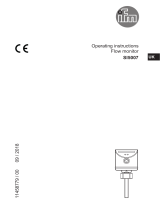
PI17xx Electronic pressure sensor
2
Contents
1 Preliminary note ............................................................. 4
1.1 Symbols used.......................................................... 4
2 Safety instructions............................................................ 5
3 Intended use................................................................ 6
3.1 Application area ........................................................ 6
4 Function ................................................................... 7
4.1 IO-Link ............................................................... 7
4.2 IO-Link properties of the sensor ............................................ 7
4.2.1 Description IO-Link interface........................................... 7
4.2.2 Internal unit temperature.............................................. 8
4.2.3 Counter overpressure events .......................................... 8
4.2.4 Optical localisation .................................................. 8
4.2.5 Event logging ...................................................... 8
4.2.6 Operating hours counter.............................................. 8
4.2.7 Switching cycles counters............................................. 8
4.3 Defined state in case of a fault ............................................. 9
4.4 Operating modes ....................................................... 9
4.4.1 2-wire operation .................................................... 9
4.4.2 3-wire operation .................................................... 9
4.5 Switching function (only for 3-wire operation) . . . . . . . . . . . . . . . . . . . . . . . . . . . . . . . . . . 9
4.6 Analogue output........................................................ 10
4.7 Customer-specific calibration .............................................. 10
5 Installation Aseptoflex-Vario.................................................... 12
5.1 Use in hygienic areas according to 3-A . . . . . . . . . . . . . . . . . . . . . . . . . . . . . . . . . . . . . . . 13
5.2 Use in hygienic areas to EHEDG ........................................... 13
5.3 Ventilation diaphragm.................................................... 14
5.3.1 Function ventilation diaphragm......................................... 14
5.3.2 Orientation filter cover................................................ 14
5.3.3 Replace filter cover.................................................. 14
6 Electrical connection.......................................................... 16
7 Operating and display elements................................................. 17
8 Menu...................................................................... 18
8.1 Menu structure: Main menu................................................ 18
8.2 Explanation of the main menu.............................................. 18
8.3 Menu structure: Level 2 (extended functions) . . . . . . . . . . . . . . . . . . . . . . . . . . . . . . . . . . 19
8.4 Explanation of menu level 2 ............................................... 19
8.5 Menu structure: level 3 (simulation). . . . . . . . . . . . . . . . . . . . . . . . . . . . . . . . . . . . . . . . . . 20
8.6 Explanation of menu level 3 ............................................... 20
9 Parameter setting............................................................ 21
9.1 Parameter setting in general............................................... 21
9.2 Configure display (optional)................................................ 24
9.3 Set output signals....................................................... 25
9.3.1 Setting of the output function........................................... 25
9.3.2 Set switching limits.................................................. 25
9.3.3 Define switching limits for the window function . . . . . . . . . . . . . . . . . . . . . . . . . . . . . 25
9.3.4 Scale analogue value for OUT2 ........................................ 25
9.4 User settings (optional)................................................... 26
9.4.1 Zero point calibration and adjustment of final value of the measuring range . . . . . . . 26
9.4.2 Define incorrect behaviour of the outputs . . . . . . . . . . . . . . . . . . . . . . . . . . . . . . . . . 26
9.4.3 Set delay time for the switching outputs . . . . . . . . . . . . . . . . . . . . . . . . . . . . . . . . . . 26
9.4.4 Set output logic for the switching outputs . . . . . . . . . . . . . . . . . . . . . . . . . . . . . . . . . 26
9.4.5 Set damping for the switching signal . . . . . . . . . . . . . . . . . . . . . . . . . . . . . . . . . . . . . 27
9.4.6 Set damping for the analogue signal . . . . . . . . . . . . . . . . . . . . . . . . . . . . . . . . . . . . . 27
9.5 Service functions........................................................ 27
9.5.1 Read min/max values for the system pressure . . . . . . . . . . . . . . . . . . . . . . . . . . . . . 27
9.5.2 Reset sensor / parameter............................................. 27
























